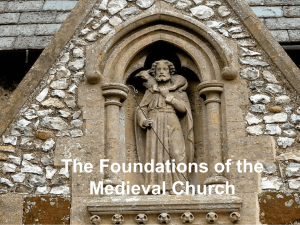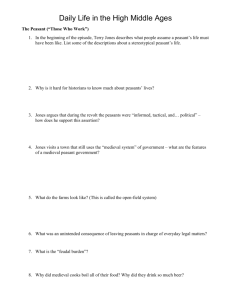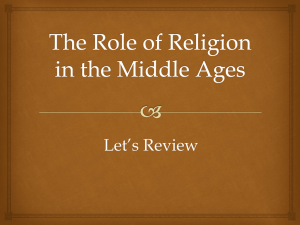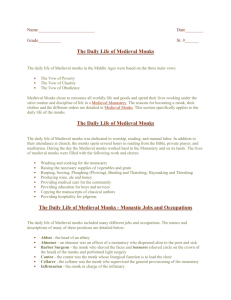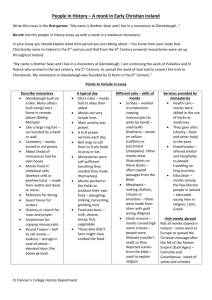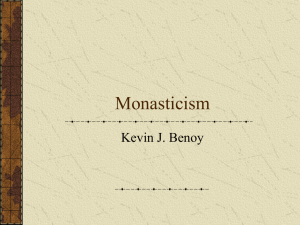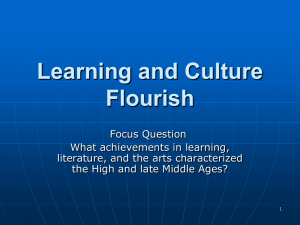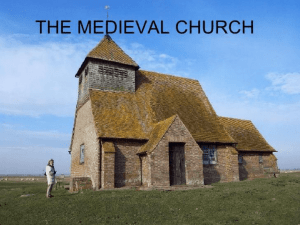Chapter 18-4: Christianity and Medieval Society
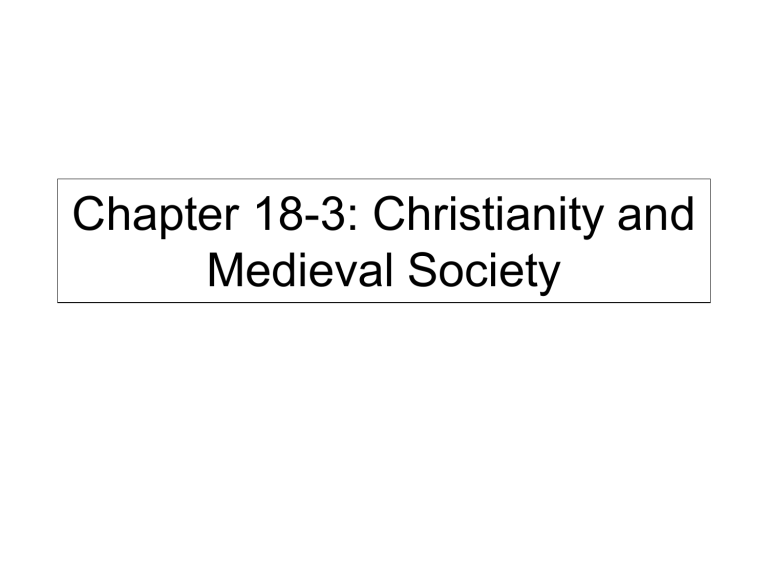
Chapter 18-3: Christianity and
Medieval Society
Reading Check
18-3
Essential Questions
• What shaped both society and politics in medieval Europe?
• List the similarities and differences among monks and friars.
• Explain who created the first universities and what was taught.
• How did the church influence the arts in medieval Europe?
Christianity and Medieval Society
The Big Idea
The Christian Church was central to life in the Middle Ages.
Main Ideas
• The Christian Church shaped both society and politics in medieval
Europe.
• Orders of monks and friars did not like the church’s political nature.
• Church leaders helped build the first universities in Europe.
• The church influenced the arts in medieval Europe.
Main Idea 1:
The Christian Church shaped society and politics in medieval
Europe.
• In the Middle Ages the life of the people revolved around the church.
• Church officials, called clergy , and their teachings were very influential in European culture and politics.
Influence of the Church
Markets, festivals, and religious activities all revolved around the church.
People wanted to see religious sites, so they went on pilgrimages, which are journeys to religious places.
One popular destination was
Canterbury,
England, which is outside London.
The famous book
Canterbury Tales is written about a group of pilgrims who went on a pilgrimage.
The Church and Politics
• The church gained political power during the Middle Ages.
• The church was one of the largest landholders in Europe because many people left land to the church after they died.
• Of all the clergy, bishops and abbots were the most involved in political matters.
• They became political advisers. Some became so involved in political matters that they spent little time dealing with religious affairs.
Main Idea 2:
Orders of monks and friars did not like the church’s political nature.
Not everyone was happy with the involvement of the church in politics.
Among those who were unhappy were a group of French monks, the
Monks of Cluny.
The Monks of Cluny
• They were a group of monks who followed a strict schedule of prayers and religious services.
• These monks formed a religious order called the Cluniac monks. A religious order is a group of people who dedicate their lives to religion and follow common rules.
• The Cluniacs became an example of how monks should live. New monasteries were built to follow their example.
• Some people felt that the Cluniacs were not strict enough, so they formed new orders. They practiced vows of silence and isolation.
• Women became nuns and formed orders known as convents.
• Monks and nuns did a great deal for society.
– Collected and stored texts that explained Christian teachings
– Copied these documents and sent copies to other monasteries across
Europe
Friars
• Dominicans and Franciscans were groups known as friars , people who belonged to religious orders but lived and worked among the general public.
• Friars lived simply and wore plain robes and no shoes. They owned no property and roamed about, preaching and begging for food.
• Their main goal was to teach people how to live good Christian lives.
Connection to Music
“Are You Sleeping?”
Are you sleeping,
Are you sleeping,
Brother John,
Brother John?
Morning bells are ringing,
Morning bells are ringing,
Ding, ding, dong,
Ding, ding, dong!
http://www.youtube.com/watch?v=QfPNHQNT8XA
What are similarities and differences in Monks and Friars?
Main Idea 3:
Church leaders helped build the first universities in Europe.
Although some people were withdrawing from the world into monasteries, there were others who wanted to learn more about the world. This led to the creation of the first universities.
Early Universities Created by the
Church
• The church’s goal was to teach people about the church.
• Most teachers at the church-created universities were clergy.
• Besides religion, the universities taught law, medicine, astronomy, and other courses.
New Ideas
• As people began to study new subjects, they developed new ideas.
• Some people in the university began to wonder how human reason and Christian thought were related.
• Thomas Aquinas , a Dominican philosopher, argued that rational thought could support Christian beliefs.
• Thomas believed that God had created a law that governed how the world operated, called natural law . He believed that if people would study and learn more about this law, they could learn to live the way God wanted.
Main Idea 4:
The church influenced the arts in medieval Europe.
Throughout the Middle Ages, religious feelings inspired artists and architects to create beautiful works of art.
Religious Architecture
Churches became works of art.
The grandest churches were called cathedrals, large churches in which bishops led services.
Towering Gothic cathedrals were built in Europe in the 1100s.
Gothic churches were much taller than older churches and had huge windows of stained glass.
Religious Art
• Paintings and tapestries were created to show respect for God.
• Priests wore highly decorated robes, sometimes with threads made of gold.
• Monks copied beautiful religious books with gold and silver that made the pages glow, often called illuminated .
Taller
Gothic Cathedral in
Westminster, England
Stained glass
Large
Windows
Gothic
Arches

